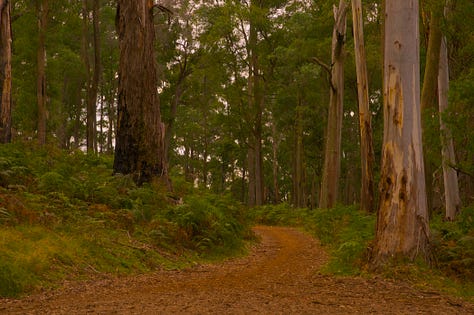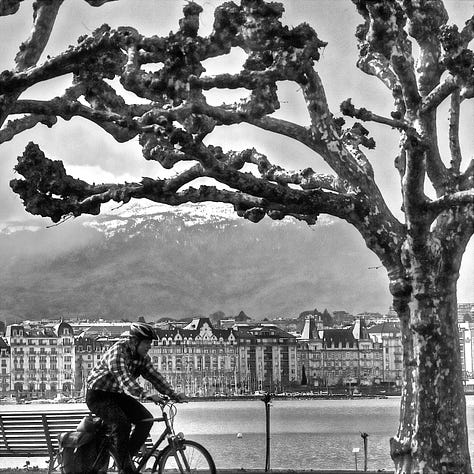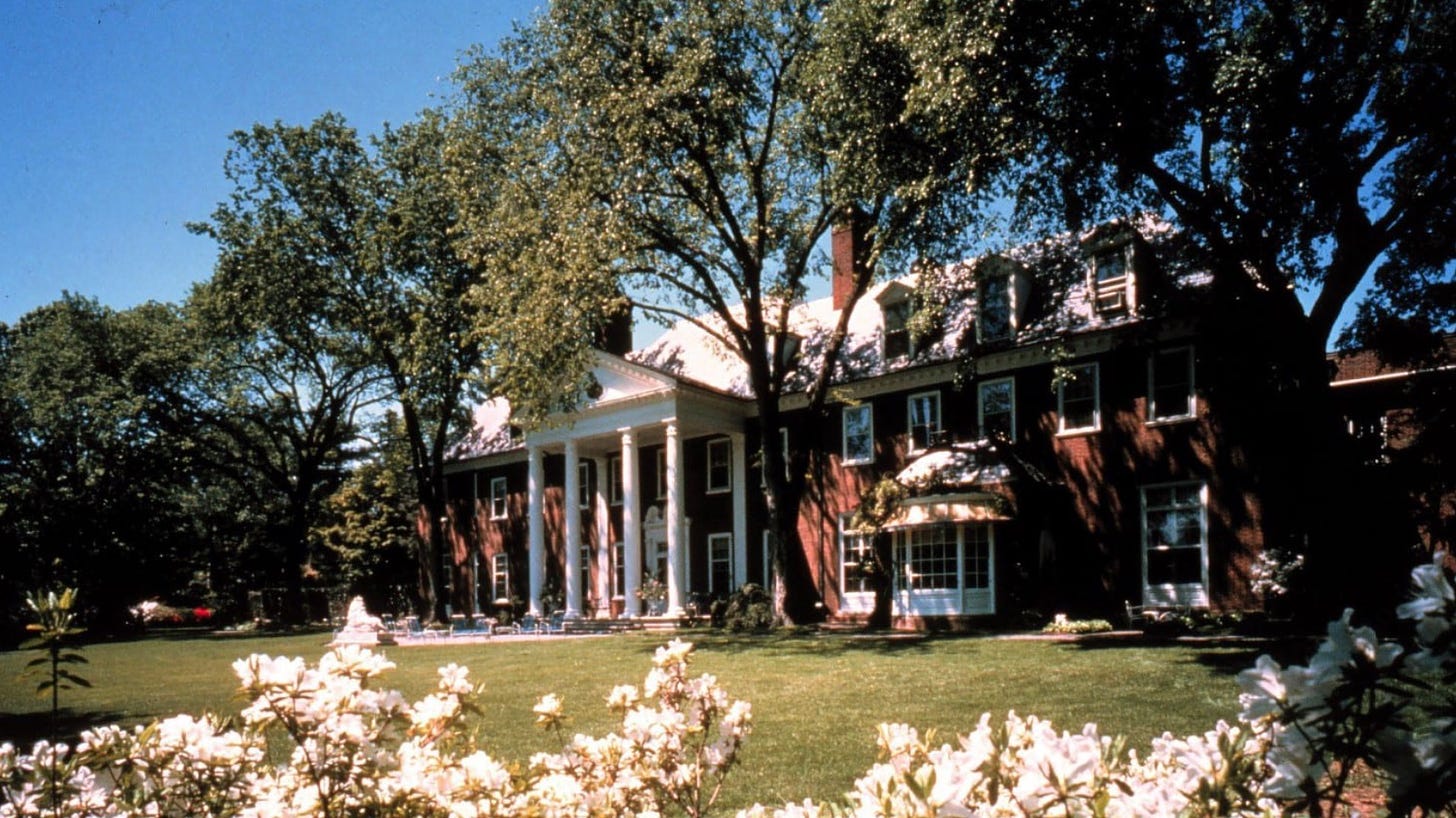Mount Buffalo, Victoria, Australia. I watched this young man for more than an hour. He was trying to get enough momentum in his run up to carry him over the top of an imposing granite rock formation. Despite his persistence, no matter how hard he tried, gravity always brought him back to earth before he could get above half way. Nor could he ever run fast enough to leave his shadow behind. Just like our shadow, just like gravity, no matter how hard we try, no matter where we travel, if we’re not happy with ourselves right where we are, today, no other place on earth can make us happy. Travel can be expensive, and it can be purposeful, but it can never be an escape.
I admit it, I’m a bit of a novelty when it comes to travel. I rarely take holidays.
One of my oft-quoted mantras is, “Everyday is a holiday.”
The life-philosophy behind that mantra assumes that unless we can find a way to enjoy what we’re doing, day to day, for our work, family, sports, music, cultural activities — and whatever — then we probably should be finding something else to do.
Still, I travel a lot, and I’ve enjoyed many destinations with my wife, children, grandchildren, and business colleagues, all over the world.
While I enjoy everywhere I go, I never travel for escape, or even for relaxation. I’ve circumnavigated this planet many times, poking around souks, museums, markets, historic sites, shrines, worship centers, pyramids, amusement parks, and well … anywhere and everywhere that seems of interest in the moment.
But, I always get to visit such special interest places as adjuncts to the business or social impact purpose for which I originated the travel.
For example, some years ago, I had occasion to visit a film producer in Verona, Italy. Verona is the setting for Shakespeare’s Romeo and Juliet. Naturally, my wife and I checked out the local points of interest while there, and a visit to Venice was an easy excursion from Verona. I acquired the film rights I was seeking, and managed to get the bonus of exploring historic and cultural phenomena in the process.
My photo library has many thousands of images. A vast catalogue of treasured experiences are tucked away in the photo vaults and memory banks. But none of it comes as a result of escape vacations. If you like escape vacations, go for it. If I want “escape,” I stay home! But either way, wherever we go, our shadows follow us. Gravity is always in effect. The self will always prevail. From ourselves, there is no escape, so why try?



























Our excellent friend and business colleague, Marina Bird, wrote a story with a similar theme for ESG News (https://esgnews.com/when-art-speaks-to-you) …
When Art Speaks to You
Editors: We recently caught up with our colleague Marina Bird, in Dubai, where she was busy establishing new distribution outlets for ESG News.
How to “travel with meaning.”
“Travel with meaning” is a phrase that can be interpreted in many ways. It could mean traveling with a purpose or goal in mind, traveling to learn about different cultures, or traveling to make a positive impact on the world. Traveling with meaning can be a transformative experience that broadens your perspective of life, people and the world at large.
A perfect example of “Traveling with meaning” occurred for me recently when I was visiting with a friend in [Washington DC], and I was told that there was a very special place that I needed to visit. The excursion that followed brought me to Hillwood Estate Museum & Gardens located on Linneal Avenue in northwest Washington, D.C. The pristine estate boasts 13 acres of exquisite formal gardens which surround a 36 room mansion which speaks elegance, culture, and old world history. This artful treasure is the former residence of businesswoman, socialite, philanthropist and collector, Marjorie Post, which upon her passing, was donated by her request to be a museum to educate and inspire the public.
Marjorie Merriweather Post (1887-1973) was the only child of C.W. Post – founder of Postum Cereal Company (now known as General Foods Corporation). Post’s love for art began when she inherited her father’s business empire and immense fortune at the age of 27, making Post the wealthiest woman in the United States for much of her lifetime. With nearly unlimited resources, Post became involved in many philanthropic ventures which included supporting the Red Cross, funding a U.S. Army hospital in France and funding and personally supervising a Salvation Army feeding station throughout the Great Depression. Though fully engaged in helping humanity around her flourish even in difficult circumstances, her great passion for art brought her to live much of her life in the pursuit of its collection and curation. Ms. Post held that art speaks to all of us, and firmly believed in the importance of spreading diversity and equality through art and in sharing this message with others.
They say when art speaks to you – listen.
In the case of Marjorie Post’s vast and varied collection, her art speaks to everyone who enters her purposeful and carefully curated sanctuary. She collected many modes and genres of artwork, including paintings, sculptures, and decorative objects from all over the world. She espoused that art is a universal language that transcends cultural barriers and gathers people together. Post also held that through the utilization of the power of the arts, people will not only better recognize and understand their differences, but also perceive and understand their alikeness and community despite those outward differences.
The procurement of her personal art collection drew Ms. Post to many international settings and eventually even created an opportunity for her to facilitate diplomatic relations between American and Soviet officials. One of the ways in which Post helped to develop U.S. diplomatic aims was by thoughtfully designing and hosting formal dinners at different residences, which included her home, Hillwood Estate, in Washington, D.C.
During her time abroad, she assembled a vast collection of imperial Russian works of art, which are still displayed today at Hillwood, exactly as she curated them. One of the largest categories of Post’s art collection — which includes Fabergé eggs, a crown, furniture, silver and gold works of art, and rare and valuable liturgical items — is porcelain. Ms. Post frequently received gifts of Russian porcelain as tokens of her time in the Soviet Union. In return, Marjorie Post gifted numerous Soviet officials with American porcelain and glass, mirroring the diplomatic practice of exchanging gifts.
Together with being the most comprehensive collection of Russian imperial art outside of Russia, Post’s art acquisitions also contain a distinguished 18th-century French decorative art collection. Her artworks at Hillwood include works by renowned artists such as Vincent van Gogh, Claude Monet, Pierre-Auguste Renoir, and Pablo Picasso, while simultaneously promoting lesser-known artists from diverse backgrounds. Because of Marjorie Post’s eclectic and inclusive love of all art, it brought her to actively seek out, and purchase artwork by African-American, Native American, and Asian artists.
Post’s passion for promoting diversity and equality through art continues to inspire people today. Her collection and the Hillwood Estate, serve as a reminder of her dedication to celebrating and preserving any and all cultures through the mediums of beauty and art. The Hillwood Estate Museum continues to educate and inspire visitors about the importance of diversity and inclusion through its purposefully various public exhibitions and programs.
Through Hillwood Estate and its vast art assemblage, Marjorie Post has left a valuable legacy that continues to promote intercultural understanding and appreciation. Each piece of art tells a unique story that connects us to different cultures and broadens our perspectives.
Ms. Post loved to have a fresh orchid from the Hillwood gardens at her breakfast table.
After visiting the Hillwood Estate, the orchid has become for me a symbol of inclusivity and diversity which brings people together and is a testament to the power of art to unite us all. As I sit and contemplate the orchid I now have at my own breakfast table, I am thankful to Ms. Post and my dear friend who introduced me to Hillwood.
Following in Marjorie Post’s footsteps, we can use the universal language of art to promote diversity, understanding and cross-cultural unity. Art has the power to transcend barriers and bring people together. It is up to us to embrace and celebrate its diversity.
Inspiration is so powerful and quite often unpredictable, sometimes you feel it in nature’s patterns, sometimes you can find it in a child’s laughter or after visiting a beautiful place like Ms. Post residence.
Her contribution has inspired me to think about what else can be done, how each business or family trip can be meaningful. It’s not just about the destination, it’s about the journey – the people you meet, the stories you collect, and the growth you experience — and your own state of being wherever you are.







